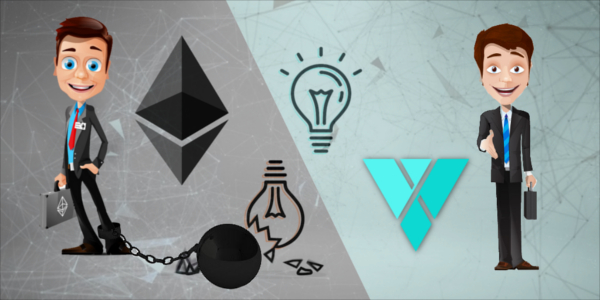Ethereum Platform Dependent on Raiden Network

Perhaps the Ethereum platform’s most overlooked flaw is its dependence upon outside solutions. Unbeknownst to many, this dependence extends to the platform’s payment and scalability solutions. To make matters worse, few of these outside solutions appear ready for general use. Among the best known solutions are Plasma and the Raiden Network, two promising technologies that are still being beta tested.
- Scalability Threatens the Future of the Blockchain :
The flaw facing Ethereum is the same one plaguing and limiting all blockchain protocols: scalability. Simply put, scalability refers to the size limitations placed upon the blocks within the blockchain. For instance, Bitcoin’s block size is famously limited to one megabyte.
Ethereum has a similar constriction known as the gas limit. The difference is that Ethereum’s size is determined by voting among those who buy gas (or space), while Bitcoin’s blocks are restricted by size.
Either way, these limitations can severely limit the speed and volume at which the blockchain operates (as they restrict how many transactions can be made). At present, a Bitcoin block is limited to conducting between 3 and 4 transactions per second (between 180 and 240 transactions/minute). Ethereum is somewhat faster as it conducts about 20 transactions/second (about 1,200 transactions/minute).
- The Blockchain is Not Fast Enough :
Unfortunately, these size limitations hamper both Bitcoin & Ethereum and their quest to become commercially viable. As it stands, several competing blockchain solutions have already proven to conduct transactions at an exponentially faster rate. Moreover, they are far better situated to handle the large volume of transactions that come with mass adoption.
What are they up against? On average, PayPal handled 193 transactions/second in 2016 (11,760 transactions/minute). At its best, PayPal was able to handle 450 payments/second (27,000 transactions/minute) during Cyber Monday in 2015.
That’s far less than Visa, which claims to have processed 1,667 transactions/second (100,020 transactions/minute) in 2016. Indeed, Visa and MasterCard’s potential transaction volume might be far higher than even these numbers suggest. In December 2017, MarketWatch’s Ryan Vlastelica estimated the combined theoretical volume for these two credits cards as being roughly 5,000 transactions/second (300,000 transactions/minute).
Critics assert that mass adoption will leave consumers waiting hours or even days to complete a Bitcoin transaction. In contrast, the Visa payment made at the supermarket transfers to your bank statement before your groceries are in the bag. Simply put, cryptocurrency will not be a competitive payment solution until it offers a speed similar to that of Visa and MasterCard. Retailers will simply not accept a payment solution that takes 20 minutes (or longer) to process a transaction. Which is why developers have such a keen interest in advancing blockchain scalability solutions.
- The Problem with the Raiden Network :
The Raiden Network is one of two efforts designed to make the Ethereum (ETH) and ERC20-protocol utility tokens as scalable as Visa or MasterCard.
In order to achieve this, Raiden is building a sidechain, a separate ecosystem far easier to scale and many times faster than that offered by the existing Ethereum architecture. If it works as intended, Ethereum will have the capability to instantly process transactions and execute smart contracts.
Unfortunately, nobody knows when the Raiden Network will actually be operational (including the Raiden team). Although the Raiden team promised a demonstration in March 2017, they were still upgrading the network’s software and architecture nearly a year later.
As the previous link indicates, the Raiden Network itself is still unstable and not ready for general use. Worse yet, the Raiden Team remains shorthanded and on the lookout for engineers willing to join their effort.
- Vitalik Buterin says No to Raiden Network :
Ethereum co-creator Vitalik Buterin’s response to The Raiden Network has been to simply design an alternative. Named Plasma, Buterin’s Raiden alternative is being designed with the help of Lightning Network whitepaper author Joseph Poon.
Envisioned as a solution for “scalable autonomous smart contracts”, Plasma will be supported by Ethereum. Buterin and Poon claim Plasma will be faster, more stable, more scalable, and cheaper than the existing Ethereum network. Unfortunately, Plasma only seems to exist as a whitepaper that Poon and Buterin have posted online.
Plasma’s existence underscores Buterin’s skepticism about Raiden’s feasibility. It also undercuts Raiden’s future support as well. Given Buterin and Poon’s desire for an alternative, Ethereum users can only conclude that Raiden technology is either flawed or problematic.
- XTRABYTES’ VITALS Network as an Effective Blockchain Scalability Solution :
In contrast to Raiden, XTRABYTES’ VITALS Network is a scalability solution instrumental to the XBY platform. More specifically, the VITALS Network is envisioned as a highly decentralized substructure to the blockchain. It reflects a radically different architecture and provides multiple advantages over traditional decentralized networks. Moreover, VITALS incorporates two network components that promise greater stability and scalability.
Among these are the network’s STATIC (Services Transactions and Trusted in Control) nodes. Each STATIC is designed to validate transactions at the node, allowing for instant transaction processing. The STATIC nodes will facilitate direct and fast transactions via a VPN-like network called VITALS (Virtual Information Transmission Aligning STATICS).
Another essential component incorporated within the VITALS Network is called PULSE (Ping Unified Ledger Synchronization Equalizer). As the network’s instant communication solution, PULSE automatically and instantly notifies VITALS every time a transaction is made. Once initiated, VITALS processes a transaction as soon as it is made.
Subsequently, each transaction is distributed to a specific STATIC node for review. STATIC nodes have the capability to limit fraud and other problems by creating a permanent record of every transaction. This capability also enables sampling and other quality-control methods to detect fraud and transaction flaws.
Like the Raiden Network, the VITALS Network is still under construction. As a scalability solution, it will help the blockchain become a commercially-viable technology. However, it also has the potential to serve as a fully comprehensive blockchain solution.